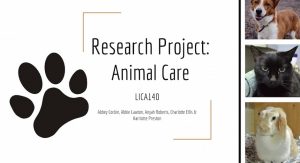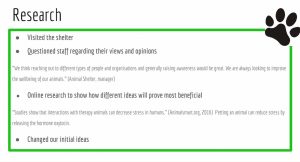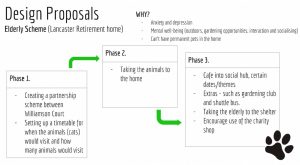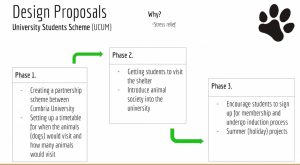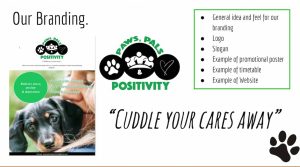Animal Care Project
Following on from my last post, about the final project in design, I will now look in more detail at our project and what our design proposal was.
We decided to use the animal shelter, Animal Care as our base for our ideas. This is the business we would link with the residents.
Initial Ideas
Initially we thought we should try and link Animal care, with schools and improve children’s wellbeing by taking animals to the schools and allowing the children to interact with the animals.
We wanted to talk to the shelter about what sorts of animals would be suitable for this. As well as if they would want people coming to the shelter or if the animals should go to the people.
We needed to look around the shelter and see what sort of scale it was as well as if it was suitable to have people come to the shelter.
Research:
After doing our initial secondary research, we went to visit Animal care. It was much easier than we thought, as it is vey close to Lancaster City centre. This meant a quick bus ride for us.
We then looked at all the animals and the facilities the shelter had. We spoke to staff about our initial ideas.
It was so beneficial for us to do, as without us doing this we would have gone down the children and animals route. Which we discovered may not be the best idea.
This lead us to think about other ideas, and what sort of Lancashire residents wellbeing we could improve with the use of animals.
We talked with the head of the animals at the shelter, and Michael, a man who deals with the link between the shelter and the public.
He was a great source of information. By talking to him and thinking about our ideas we came up with the idea of Retirement homes and Universities as being a good way of linking animal care to Lancashire residents.
We found out the the shelter has stay in animals that can never be adopted, these animals are used to seeing people and are what the shelter use for sponsorship animals. Having both cats and dogs, we decided these would be perfect for the job of therapy animals.
We then talked to UCUM and the retirement homes to see if this would be something they would be interested in.
After getting their views we confirmed our ideas, and began to come up with scheme ideas, and plans.
Without doing this research we would not have ended up with the ideas we did, this showed us just how important it was, and that you can not assume ideas will work.
Design Schemes:
We wanted to brand our ideas, and have a sort of business that we could in theory show people and become the link between Animal Care and the university or retirement home.
This lead to ‘Paws, Pals and Positivity’ being created. Our brand, with the slogan ‘Cuddle Your Cares Away’. We felt this very simply showed what we were trying to do.
Our design proposal consisted of two Schemes, similar in design but changing small elements so that each was tailored to the business we wanted the to work with.
At this point we decided the work up more so each person knew what they were doing, it was amazing how much work we got done and how well we worked as a team. It was a really great experience, and showed that from a very basic idea we were able to come up with a well thought out idea.
The basic idea was the the Retirement Home Scheme would involve the cats from Animal care going to the home and interacting with the residents. We slip the scheme into phases to allow us to clearly illustrate how our plan would work.
In terms of benefits, we worked it around mental wellbeing in the initial stages, then residents would be able to go to the shelter in phase three if they wished. Allowing physical wellbeing to be improved too.
For our UCUM Scheme, we based this more around dogs, as the students and teachers would be younger and be able to be more active with the dogs. We wanted to use the dogs to reduce stress during exam periods and stressful times of the year, for both students and staff.
We gave a very detailed description of both of our schemes and the benefits to all parties including animal care in our 5000 word report. As well as in our presentation. The presentation slides for the schemes show how we broke the ideas down.
Advertising:
We then wanted to go a bit further in our project. As we had already completed the brief, but we thought by showing the kinds of branding we would use, and mock websites would show what we were thinking. It was a way of showing the design and marketing skills we had learnt too.
Reflection:
Upon reflection of our project, i felt we really learnt how to work as a group, and we did this very well. It for me, gave a really good idea of what i had to come over the next few years at Lancaster. I am very excited for this, as i really enjoyed doing this project. Looking at animal care and being able to come up with design ideas, and branding ideas was really enjoyable, it was challenging as the brief was quite open. However, this allowed us to run with the idea, and explore different ideas.
I think we have all learnt from this as well, as ironically making the mistake at the begging of the project helped us in the long run. It showed us what we should not do and what we therefore, needed to do. We most defiantly learnt from these mistakes, and I feel corrected them, which allowed us to produce a well rounded project.
It seems strange that the first year of design is over already.
However, this final project was i feel the best, it incorporated all the skills we had learnt, such as the ethnography methods we used in out last project, as well as the idea generation in the first few weeks of Design at Lancaster.
I greatly look forward to what Design has to offer over the next few years, and I am sure I will be pushed just like I have been this year.
